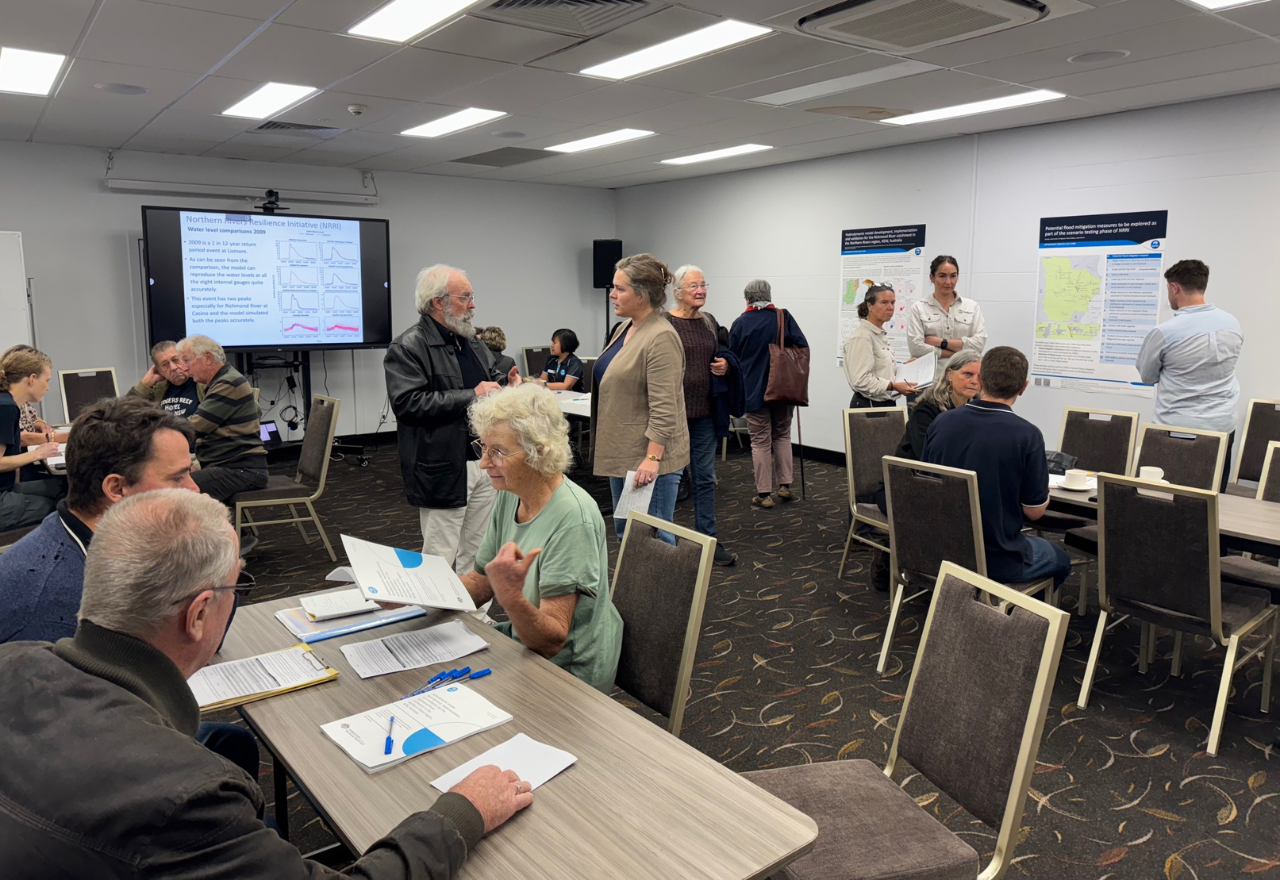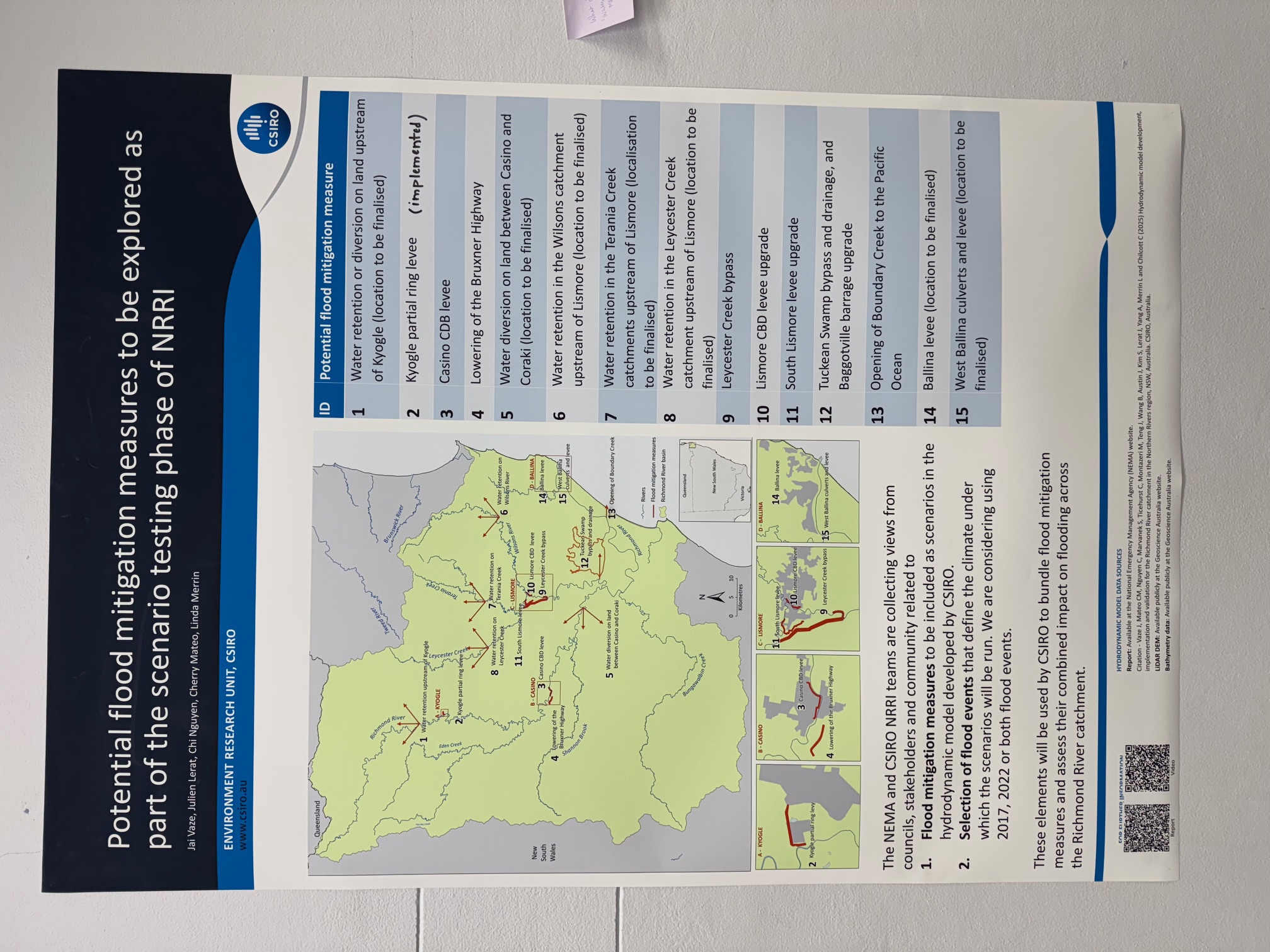Strong turnout for Lismore CSIRO community forum
Simon Mumford
04 August 2025, 7:12 AM
 CSIRO team members listening to community thoughts at the Workers Club today
CSIRO team members listening to community thoughts at the Workers Club todayThe Lismore date for the Northern Rivers Resilience and Initiative (NRRI) community visit, run by NEMA (National Emergency Management Agency) and the CSIRO as their science partner, saw a strong turnout at the Lismore Workers Club.
From opening time at 10am, there were reports of people lined up eager to hear what the CSIRO team had to say about the process and keen to voice their thoughts as to what flood mitigation results they would like to see and what options should be included in the modelled scenarios.
CSIRO Lead Scientist Jai Vaze said he has met with seven councils that are part of the Richmond River catchment, with Clarence to be completed on August 19. Each council viewed the implementation model that was released on 30 June 2025, and voiced their opinions as to what options they feel will deliver the best flood mitigation results.
"They are a good starting point, and we are asking the community what do they want us to do," Mr Vaze told the media today."
Once the community meetings have been completed, Kyogle being the last this Friday, the data will be collected and analysed.
"Whatever the majority wants, we'll then put together the scenario options, which will be a couple of things for Lismore and upstream, some for Kyogle, some for Casino. So, we're looking at the whole Richmond scale flood mitigation. The whole focus is flood mitigation.
"And so after that, we'll put together, based on the community needs, which makes sense and which can be modelled. Then basically we'll come back again to the councils and the community, show them that this is the preferred one. Are they okay with it? If that's okay, and if it's approved by the Federal Minister, then we run those. The 30th of June, 2026, we will put out a report which will show that for scenario one, what will be the reduction? Scenario two, what will be the reduction?"
Mr Vaze stressed that neither he nor his team has promised any flood mitigation results.
"We haven't promised one centimetre. If the scenario shows, when modelling shows there is no change, that's what we put. If it shows a larger change, we'll show that.
"The CSIRO job finishes there. After that, it's more policy, so the state and federal agencies and ministers take over from there. We will be providing, still, the scientific advice."
As we already know, one scenario will be bundled with a number of options, and there could be two, three, four or five scenarios modelled to get the best result for the entire Richmond River catchment.
"Quite a lot of them have been retained water, and hold it during the floods and then release it later. Some are about levees. Some are about nature-based solutions. We are listening to everyone. After that, what makes sense for flood mitigation will be put together. As CSIRO has said right from the beginning, nothing is finalised. Every option has equal weight."
It is still early days in the community consultation process; however, Mr Vaze said the common message coming through was to reduce the impact of future floods.
"And then some of them say that, Oh, you are the science organisation, you make the decision and just do it. We don't operate that way. We need to hear from the community what they want. And so everyone basically wants the impact of the floods, large floods to be reduced. That's the common message."
Some internal posters in the community meeting room show water retention options for Leycester Creek, Terania Creek, Wilsons River and Richmond River, levee options for Casino, Lismore and Ballina, and the opening of Boundary Creek to the Pacific Ocean.

Federal Member for Page, Kevin Hogan, and Lismore Mayor Steve Krieg were present today, asking for one of the scenarios to be modelled, to reduce the impact of a major flood by 1 to 2 metres.
Mr Hogan showed Mr Vaze his petition, which has reached over 2,000 signatures, both physically and digitally (online). You can still sign the petition here.

"I'm not here to tell them what things they should do to do that, and what things they shouldn't do. But obviously, we believe to get one to two metres off a flood, we need both engineering and nature-based solutions to do that."
"Why are we asking the CSIRO to take a metre to two metres off a flood? We think it's important for a whole lot of reasons. One is to keep people safe. We don't think nature-based solutions will keep people safe in their homes, keep people safe in their businesses, and do the mitigation that we think needs to happen to happen. So that's the priority, keeping people safe.
"The other is things like insurance. We're uninsurable at the moment on the flood plain, and we obviously, with flood mitigation, good, proper flood mitigation work, we think will give people insurance, and even credit finance is very difficult to do this.
"Lismore is one of the few communities we think along the east coast that hasn't had serious flood mitigation work done yet. If you look at a town like Grafton, a community like Grafton had back in the 1960s had a one-in-100-year levy put through. Now, again, this isn't about flood proofing. We can't flood-proof, we know that, but this is about engineering and nature-based solutions that take a reasonable amount of water off our community to make them feel safer. And again, things like insurance and affordability for insurance."
Mayor Steve Krieg thanked the CSIRO for their world-first Richmond River catchment model that accurately reflects five of Lismore's recent major floods, including 2022.
"There's no doubt that I'm not an expert in flood mitigation whatsoever, but what I am is a very passionate Lismore resident. I want to see our business community protected. I want to see our residents protected. I want to see everything that is great about our area looked after and protected, whatever that looks like.
"I've said it very publicly and very often that I back the science with this. Jai and his team are very trusted and world-renowned in modelling, so it's really great to see our community come out in such force to provide their opinions."
Greens spokesperson, Dr Luke Robinson, was also present today.
"I think it was really good to talk to Jai and his team about what their model was about and how it works, and also to learn about what the limits are on the model and what it can achieve," Dr Robinson said.
Dr Robinson was happy to look at the evidence-based science but did have concerns about political interference.
"We've got serious concerns about how the process could be co-opted by certain political elements that are only focused on doing hard engineering solutions. Our concern with a lot of the hard engineering solutions, and by that I mean things like retention basins and levees and so on, is that they don't guarantee 100% that people will be protected from any flood. The only way we can do that is to get people off the floodplain. That's 100% guaranteed if we get them off a floodplain.
"Second thing is, we don't know what the costs of those economically are going to be. I imagine if, as Kevin Hogan says, he wants to get one to two meters off the whole catchment, that is going to be extraordinarily expensive. It's going to require massive earthworks, and they will have a lot of big environmental impacts upstream. There'll be places that are flooded; they might be wrecked. They could be sensitive ecological areas. They could be people's farmland, people's properties. Those things have to be brought into account as well, and they're also cultural impacts we'll have to look at as well.
"It seems to me that the simplest and most guaranteed way of dealing with the impacts of flooding is to get people off the floodplain."
Ballina will host the next community forum tomorrow (Tuesday) at the Ballina Lighthouse & Lismore SLSC, Lighthouse Parade, East Ballina, between 10am and 6pm.
Wednesday will see the forum move to Woodburn at the Community building, 114 River Street, again between 10am and 6pm.
The final community forum will be held this Friday at Kyogle, the Community Centre, 3 Bloore Street, between 10am and 6pm.
If you cannot physically get to a venue and still want to have input, click here to lodge an online response.

